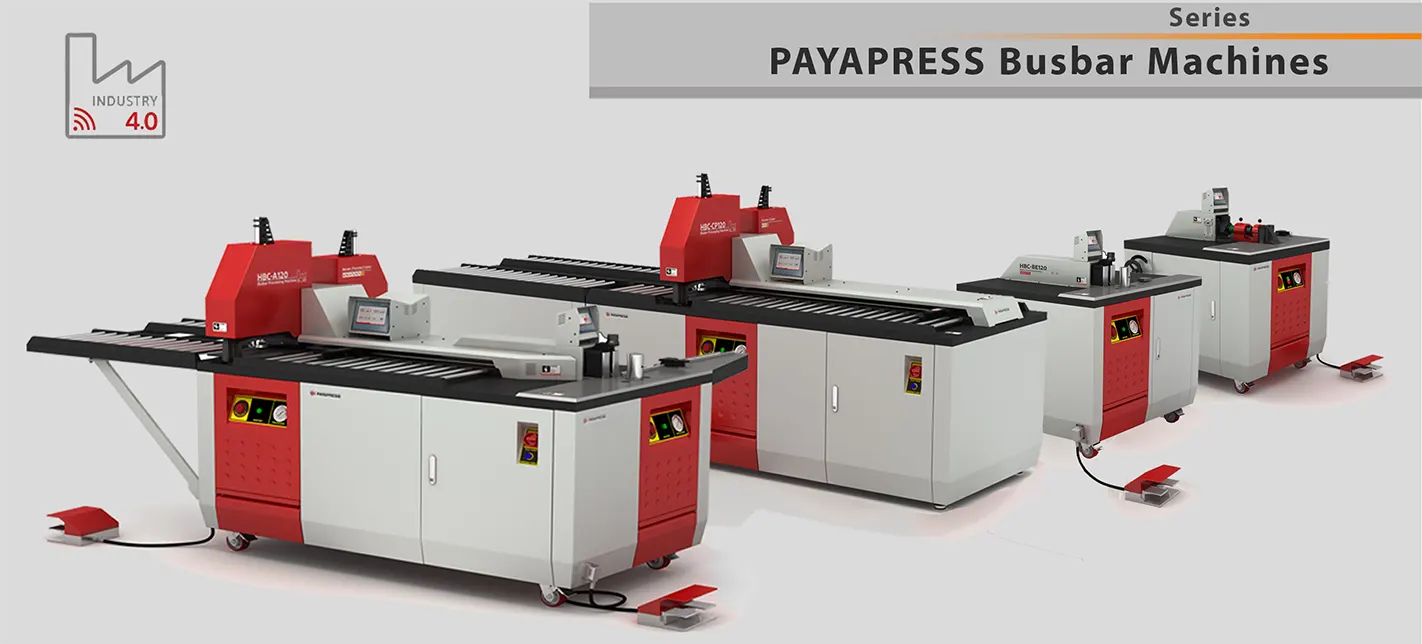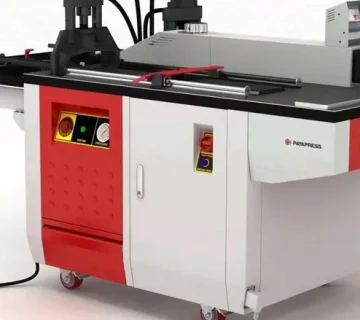In the realm of electrical engineering, the precision and efficiency of busbar processing machines are paramount. These machines, which include busbar bending machines, busbar cutting machines, and automatic punching machines, play a critical role in the production of transformers and switchgear. The accuracy of these machines directly impacts the performance, reliability, and safety of electrical systems. This article delves into the significance of busbar processing machine accuracy and its implications for the production of transformers and switchgear.
Understanding Busbars and Their Role
Busbars are metallic strips or bars, typically made of copper or aluminum, that conduct electricity within a switchgear, transformer, or other electrical apparatus. They are essential for distributing electrical power efficiently and safely. The precision in the manufacturing of busbars is crucial because any deviation can lead to electrical losses, overheating, and potential system failures.
Types of Busbar Processing Machines
- Busbar Bending Machines: These machines are designed to bend busbars to specific angles and shapes. The accuracy of the bend is critical to ensure proper fit and function within electrical systems. Variants include hydraulic busbar bending machines, and manual busbar bending machines.
- Busbar Punching Machines: These machines punch holes or shapes into busbars. Precision in punching is vital to ensure that the busbars can be securely fastened and connected within the electrical system. Automatic punching machines and CNC busbar punching machines are commonly used for high precision.
- Busbar Cutting Machines: These machines cut busbars to the required lengths. Accurate cutting ensures that busbars fit perfectly within the designated spaces in switchgear and transformers. CNC busbar cutting machines offer high precision and efficiency.
- 3-in-1 Busbar Machines: These versatile machines can perform cutting, punching, and bending operations. They are highly efficient and ideal for workshops that require multifunctional capabilities.
The Importance of Accuracy in Busbar Processing
- Electrical Performance: Accurate busbar processing ensures optimal electrical performance. Precise bends, cuts, and punches minimize electrical resistance and ensure efficient power distribution. Inaccurate processing can lead to increased resistance, resulting in energy losses and potential overheating.
- Safety: Safety is paramount in electrical systems. Accurate busbar processing reduces the risk of electrical faults, short circuits, and fires. Properly processed busbars ensure secure connections and reliable operation of switchgear and transformers.
- Reliability: The reliability of electrical systems depends on the quality of their components. Accurate busbar processing enhances the durability and longevity of busbars, reducing the likelihood of system failures and maintenance requirements.
- Cost Efficiency: Precision in busbar processing minimizes material wastage and reduces the need for rework. This leads to cost savings in both materials and labor. Additionally, efficient processing machines, such as CNC busbar processing machines, increase production speed and throughput.
Key Features of High-Precision Busbar Processing Machines
- CNC Technology: CNC technology enables high precision in busbar processing. CNC busbar punching machines, and CNC busbar cutting machines offer automated and highly accurate operations, ensuring consistent quality.
- Hydraulic Systems: Hydraulic busbar bending machines provide powerful and precise bending capabilities. The use of hydraulic systems ensures smooth and accurate bends, even for thick and hard busbars.
- Versatility: Machines like the 3-in-1 busbar machine offer versatility by combining cutting, punching, and bending functions. This versatility is particularly useful in workshops with limited space and resources.
- Automation: Automatic busbar processing machines enhance efficiency and accuracy. Automation reduces human error and increases production speed, making these machines ideal for high-volume manufacturing.
Applications in Transformers and Switchgear
- Transformers: In transformers, busbars are used to connect various components and facilitate the flow of electricity. Accurate busbar processing ensures that these connections are secure and efficient, enhancing the overall performance of the transformer.
- Switchgear: Switchgear systems rely on busbars to distribute electrical power and protect electrical circuits. Precision in busbar processing is crucial to ensure that the switchgear operates reliably and safely. Accurate busbar bending, punching, and cutting are essential for the proper assembly and function of switchgear components.

Detailed Analysis of Busbar Processing Machines
- Busbar Bending Machines: Let’s dive deeper into the different types of busbar bending machines available:
– Hydraulic Busbar Bending Machines: These machines utilize hydraulic power to bend busbars. They are known for their strength and precision, making them suitable for bending thick and hard busbars. Hydraulic busbar bender machines can handle heavy-duty applications, and their accuracy ensures minimal material wastage and high-quality bends.
– Manual Busbar Bending Machines: These machines offer a more hands-on approach to busbar bending. While they may not offer the same level of automation and precision as hydraulic machines, manual busbar bending machines are still valuable for smaller projects and workshops with limited budgets.
- Busbar Punching Machines: Precision in punching is crucial for creating secure and reliable connections in electrical systems. Here are the different types of busbar punching machines:
– Automatic Punching Machines: These machines offer high-speed and automated punching capabilities. They can be programmed to punch holes or shapes with precision, reducing the risk of errors and increasing production efficiency. Automatic punching machines are ideal for large-scale manufacturing operations.
– CNC Busbar Punching Machines: CNC technology enhances the precision and versatility of busbar punching. These machines can be programmed to create complex patterns and shapes with high accuracy. CNC busbar punching machines are suitable for applications that require intricate and precise punching.
– Manual Punching Machines: Manual punching machines offer a more hands-on approach to busbar punching. While they may not offer the same level of automation and speed as automatic or CNC machines, they are still valuable for smaller projects and workshops with limited budgets.
- Busbar Cutting Machines: Accurate cutting is essential to ensure that busbars fit perfectly within the designated spaces in switchgear and transformers. Here are the different types of busbar cutting machines:
– CNC Busbar Cutting Machines: CNC technology brings automation and precision to busbar cutting. These machines can be programmed to cut busbars to exact lengths, ensuring consistent and accurate results. CNC busbar cutting machines are ideal for high-volume production environments where precision and efficiency are critical.
– Manual Cutting Machines: Manual cutting machines offer a more hands-on approach to busbar cutting. While they may not offer the same level of automation and precision as CNC machines, manual cutting machines are still valuable for smaller projects and workshops with limited budgets.
- 3-in-1 Busbar Machines: These versatile machines can perform cutting, punching, and bending operations. They are highly efficient and ideal for workshops that require multifunctional capabilities. 3-in-1 busbar machines offer a cost-effective solution for workshops with limited space and resources.
Choosing the Right Busbar Processing Machine
When selecting a busbar processing machine, several factors should be considered:
- Accuracy and Precision: The machine should offer high precision in cutting, punching, and bending operations. CNC machines are often preferred for their accuracy.
- Versatility: Depending on the requirements, a versatile machine like the 3-in-1 busbar machine may be ideal. It can perform multiple functions, reducing the need for multiple machines.
- Capacity: The machine should be capable of handling the size and thickness of the busbars used in your applications. Hydraulic busbar bending machines are suitable for thicker busbars.
- Automation: Automatic punching machines and CNC busbar processing machines offer higher efficiency and consistency. They are ideal for high-volume production environments.
- Cost: Consider the busbar price and the overall cost of the machine. While high-precision machines may have a higher initial cost, they can offer long-term savings through reduced material wastage and increased efficiency.
Conclusion
The accuracy of busbar processing machines is crucial in the production of transformers and switchgear. Precise busbar bending, punching, and cutting ensure optimal electrical performance, safety, reliability, and cost efficiency. Investing in high-precision machines, such as CNC busbar processing machines and hydraulic busbar bending machines, can significantly enhance the quality and performance of electrical systems. As the demand for efficient and reliable electrical power distribution continues to grow, the importance of accurate busbar processing will only increase.




No comment